Amino acids are commercially important as they are widely used in food, pharmaceutical, cosmetics and animal feed industries[1]. L-isoleucine, belonging to the L-aspartate family amino acids (AFAAs), has been widely used in such fields as pharmaceuticals, food additives, and precursors of herbicides[2].So far, Corynebacterium glutamicum has been used as the main producer of L-isoleucine[3]. As shown in Fig. 1, C. glutamicum synthesizes L-isoleucine in a split pathway from oxaloacetate via L-aspartate, L-threonine, 2-ketobutyrate and 2-aceto-2-hydroxybutyrate as the main intermediates. The oxaloacetate supply has been considered as a bottleneck for L-isoleucine production[4]. In C. glutamicum, oxaloacetate is mainly replenished by the anaplerotic pathways[5]. In contrast to many other organisms which have only one anaplerotic pathway, C. glutamicum possesses both: one is catalyzed by phosphoenolpyruvate carboxylase (PEPC, encoded by ppc) converting phosphoenolpyruvate to oxaloacetate, and the other is by pyruvate carboxylase (PC, encoded by pyc) converting pyruvate to oxaloacetate with biotin as a coenzyme[6].
It seems that PC and PEPC play distinct roles in amino acid synthesis by C. glutamicum. PC was predominant during the temperature triggered glutamate fermentation, whereas PEPC was necessary for glutamate production induced under biotin-limited conditions and overexpression of ppc effectively enhanced glutamate production in the similar conditions[7-8]. We previously reported that pyc overexpression did not result in promotion of glutamate production, but in decreased pyruvate-related byproducts accumulation[9]. Overexpression of pyc in C. glutamicum increased lysine accumulation by 50%[10],while overexpressing ppc showed only marginal effect. The amplification of PEPC activity allowed an increase in threonine production by 12%[10-11].
In summary, the roles of pyc and ppc overexpression were focused on L-glutamate, L-threonine and L-lysine so far. Nevertheless, those in L-isoleucine synthesis were unclear. In this study, the effects of pyc and ppc overexpression on synthesis of L-isoleucine were compared.
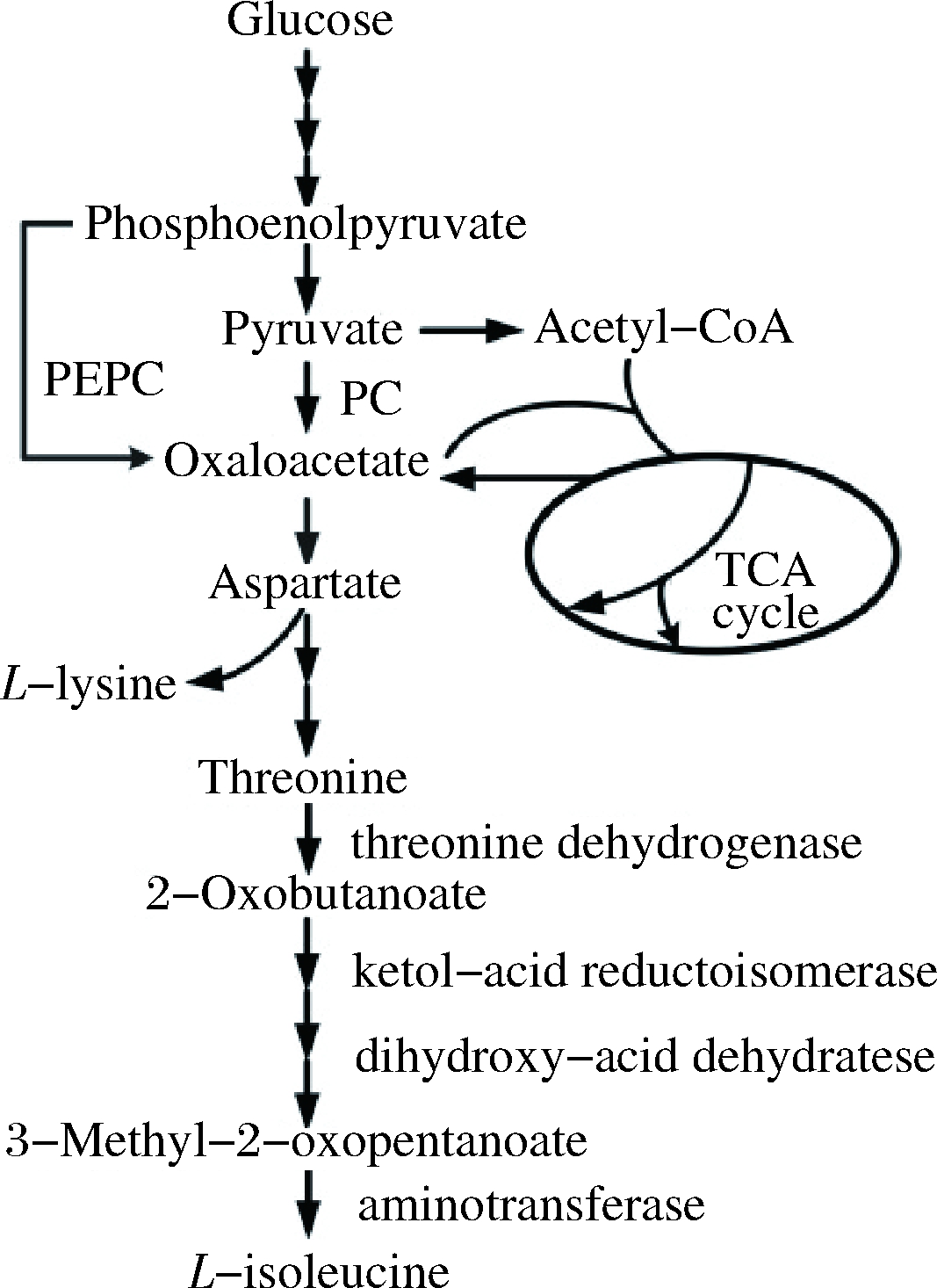
Fig.1 Biosynthesis pathway of L-isoleucine
1 Materials and methods
1.1 Materials and reagents
1.1.1 Strains, plasmids, and culture conditions
The strains and plasmids were listed in Table 1. Escherichia coli DH5α was used for vector construction and was cultured in lysogeny broth (LB) medium. C. glutamicum strains were cultured in LB medium supplemented with 5 g/L glucose (LBG). All the strains were grown at 32℃ in a shaker at 200 r/min. When necessary, the media were supplemented with kanamycin (25 μg/mL).
Table 1 Bacterial strains and plasmids
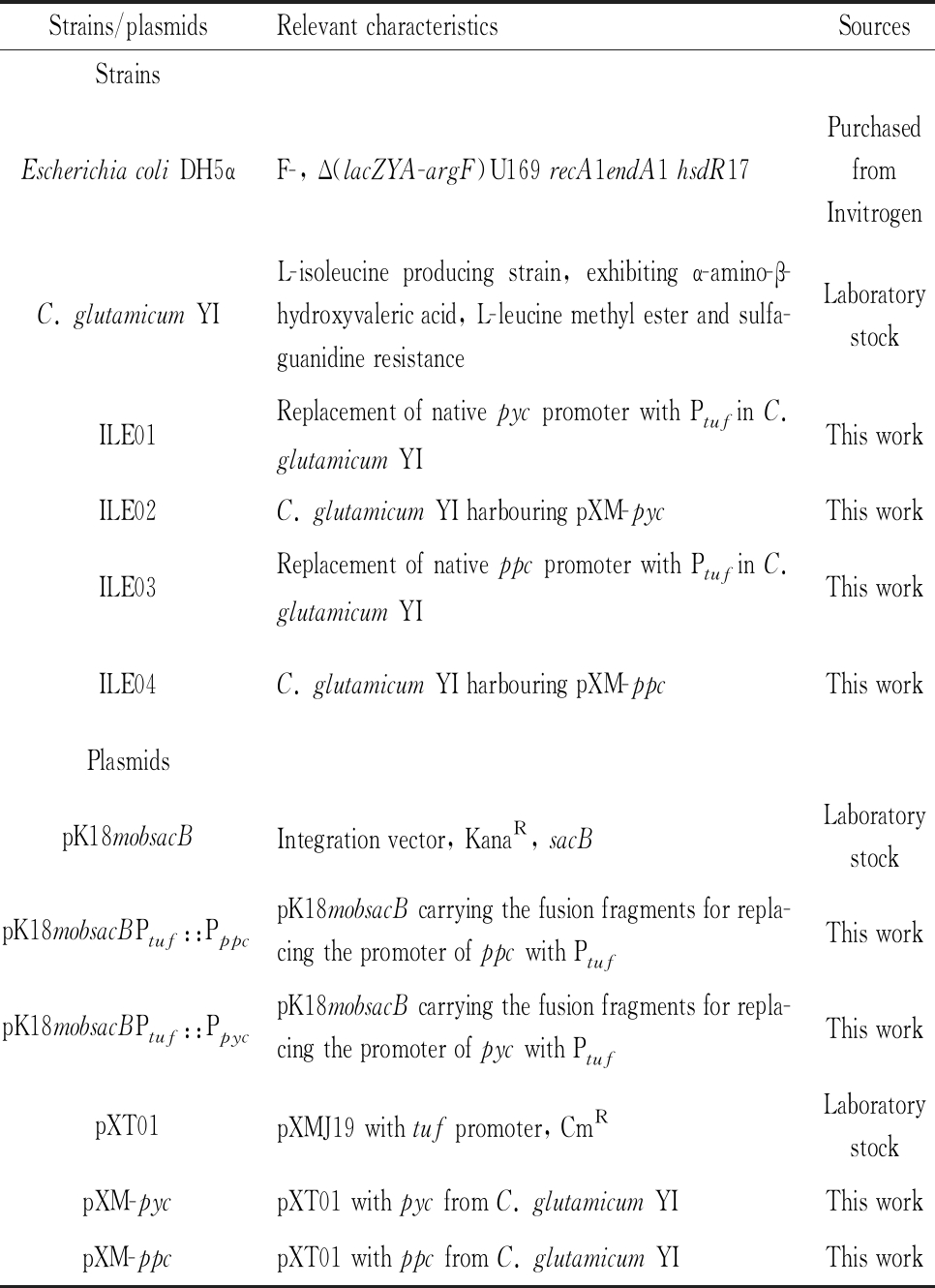
Strains/plasmidsRelevant characteristicsSourcesStrainsEscherichia coli DH5αF-, Δ(lacZYA-argF)U169 recA1endA1 hsdR17Purchased from InvitrogenC. glutamicum YIL-isoleucine producing strain, exhibiting α-amino-β-hydroxyvaleric acid, L-leucine methyl ester and sulfa-guanidine resistanceLaboratory stockILE01Replacement of native pyc promoter with Ptufin C. glutamicum YIThis workILE02C. glutamicum YI harbouring pXM-pycThis workILE03Replacement of native ppc promoter with Ptufin C. glutamicum YIThis workILE04C. glutamicum YI harbouring pXM-ppcThis workPlasmidspK18mobsacBIntegration vector, KanaR, sacBLaboratory stockpK18mobsacBPtuf::PppcpK18mobsacB carrying the fusion fragments for repla-cing the promoter of ppc with PtufThis workpK18mobsacBPtuf::PpycpK18mobsacB carrying the fusion fragments for repla-cing the promoter of pyc with PtufThis workpXT01pXMJ19 with tuf promoter, CmRLaboratory stockpXM-pycpXT01 with pyc from C. glutamicum YIThis workpXM-ppcpXT01 with ppc from C. glutamicum YIThis work
1.1.2 Primers
Primers used in this study were listed in Table 2.
Table 2 Primers used in research
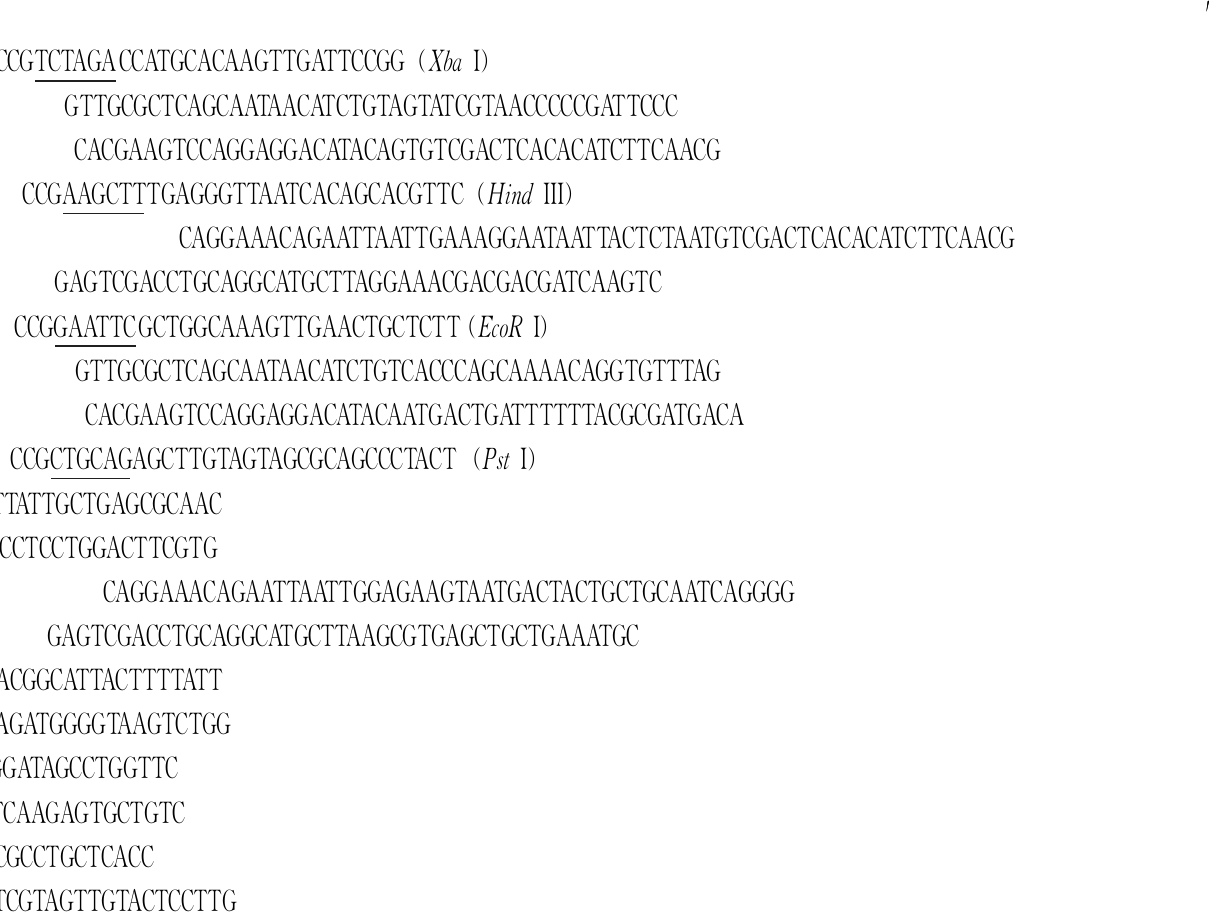
PrimersSequence(5' - 3')pyc-1CCGTCTAGACCATGCACAAGTTGATTCCGG (Xba I)pyc-2GTTGCGCTCAGCAATAACATCTGTAGTATCGTAACCCCCGATTCCCpyc-3CACGAAGTCCAGGAGGACATACAGTGTCGACTCACACATCTTCAACGpyc-4CCGAAGCTTTGAGGGTTAATCACAGCACGTTC (Hind III)pyc-6CAGGAAACAGAATTAATTGAAAGGAATAATTACTCTAATGTCGACTCACACATCTTCAACGpyc-7GAGTCGACCTGCAGGCATGCTTAGGAAACGACGACGATCAAGTCppc-1CCGGAATTCGCTGGCAAAGTTGAACTGCTCTT (EcoR I)ppc-2GTTGCGCTCAGCAATAACATCTGTCACCCAGCAAAACAGGTGTTTAGppc-3CACGAAGTCCAGGAGGACATACAATGACTGATTTTTTACGCGATGACAppc-4CCGCTGCAGAGCTTGTAGTAGCGCAGCCCTACT (Pst I)tuf-1CAGATGTTATTGCTGAGCGCAACtuf-2TGTATGTCCTCCTGGACTTCGTGppc-6CAGGAAACAGAATTAATTGGAGAAGTAATGACTACTGCTGCAATCAGGGGppc-7GAGTCGACCTGCAGGCATGCTTAAGCGTGAGCTGCTGAAATGCpyc-FCGGAAAACGGCATTACTTTTATTpyc-RTCACAAAGATGGGGTAAGTCTGGppc-FCCGAAATGGATAGCCTGGTTCppc-RGGTGGCATCAAGAGTGCTGTC16S-FAGAACCACCGCCTGCTCACC16S-RCCGTCGTCGTAGTTGTACTCCTTG
*: Recognition sites are underlined and restriction enzymes are shown in parentheses.
1.1.3 Media
Seed medium: 50 g/L glucose, 12 g/L (NH4)2SO4, 10 mg/L FeSO4·7H2O, 1.5 g/L KH2PO4·3H2O, 0.6 g/L MgSO4·7H2O, 10 mg/L MnSO4·7H2O, 0.1 mg/L biotin, 0.4 mg/L vitamin B1.
Fermentation medium for batch fermentation: 60 g/L glucose, 15 g/L (NH4)2SO4, 10 mg/L FeSO4·7H2O, 2 g/L KH2PO4·3H2O, 0.6 g/L MgSO4·7H2O, 12 mg/L MnSO4·7H2O, 0.1 mg/L biotin, 0.5 mg/L vitamin B1.
Fermentation medium for fed-batch fermentation: 80 g/L glucose, 4 g/L (NH4)2SO4, 15 mg/L FeSO4·7H2O, 0.5 g/L MgSO4·7H2O, 15 mg/L MnSO4·H2O, 1.5 g/L KH2PO4·3H2O, 3 g/L K2HPO4·3H2O, 0.1 mg/L biotin, 5 mg/L vitamin B1, 20 mL/L soybean hydrolysate and 15 mL/L corn steep liquor.
1.1.4 Reagents
Chemicals: Sinopharm Chemical Reagent Co., Ltd. Beijing; Restriction endonucleases: Primer STAR HS DNA polymerase, RNAiso Plus kit and T4 DNA ligase, Takara Bio Inc., Dalian; Ultra-SYBR Two-Step RT-qPCR Kit: CWBIO Co., Ltd., Beijing; ClonExpressTM Ⅱ One-Step Cloning Kit:Vazyme Biotech Co., Ltd., Nanjing; Primers: GENEWIZ Bio Inc., Suzhou.
1.2 Instruments
Bio-Rad MyCycler: Bio-Rad, USA; High performance liquid chromatograph (HPLC): U3000 Thermo Fisher Scientific, USA; Stepone Real-Time PCR instrument: Applied Biosystems ABI, USA; PD-10 desalting column: GE Healthcare UK Ltd., UK; Spectrophotometer UV2600: Shimadzu, Japan; SBA biosensor analyzer SBA-40D: Institute of Biology, Shandong Province Academy of Sciences, Jinan; 5-L bioreactors: Shanghai Baoxing Bio-engineering Equipment Co., Ltd., Shanghai; ZORBAX Eclipse AAA column: Agilent, USA.
1.3 Methods
1.3.1 Construction of plasmids and recombinant strains
The primers for fragments amplification are listed in Table 2. The digestion and ligation of DNA were operated according to standard protocols[12]. The transformation of E. coli DH5α and C. glutamicum were by heat shock and electroporation, respectively[13].
For the chromosomal replacement of the native pyc promoter with Ptuf in C. glutamicum YI, both upstream homologous arm (UHA) and downstream homologous arm (DHA) of pyc were PCR-amplified from the genome of C. glutamicum YI with the primer pair of pyc-1 and pyc-2, pyc-3 and pyc-4, respectively. The fragment of Ptuf was amplified from the genome of C. glutamicum YI using the primer pair of tuf-1 and tuf-2. The three fragments were purified, mixed in equal amounts, and then subjected to crossover PCR using the primer pair of pyc-1 and pyc-4. The resulting product was digested with Xba I and Hind Ⅲ, inserted into vector pK18mobsacB to generate pK18mobsacBPtuf::Ppyc. Replacement of the native pyc promoter was achieved via two rounds of recombination with ![]() generating ILE01. Similarly, the native ppc promoter was replaced with Ptuf, resulting in ILE03.
generating ILE01. Similarly, the native ppc promoter was replaced with Ptuf, resulting in ILE03.
The pyc and ppc was individually amplified from C. glutamicum YI genomic DNA using pyc-6, pyc-7 and ppc-6, ppc-7 and was cloned into the Hind Ⅲ site of pXT01 to construct pXT-pyc and pXT-ppc; the plasmids were transformed into C. glutamicum YI to obtain ILE02 and ILE04, respectively.
1.3.2 Real-time quantitative PCR
Total RNA was isolated from cells of C. glutamicum strains growing for 12 h in LBG medium according to the manufacturer’s instructions of RNAiso Plus kit and then the cDNA was synthesized. The transcription levels of pyc (with primers of pyc-F and pyc-R) and ppc (with primers of ppc-F and ppc-R) were measured and data were analyzed by the 2-ΔΔCT method[15]. Primers for real-time quantitative PCR were listed in Table 2.
1.3.3 Detection of enzyme activity
Enzyme activities were measured using crude cell extracts as the enzyme source. C. glutamicum YI, ILE01, ILE02, ILE03 and ILE04 cells grown in LBG medium (OD600=9-12) were collected, washed and resuspended in 10 mL of Tris-HCl (0.1 mol/L, pH 7.0) buffer. Then, the cells were disrupted by sonication for 20 min. The cell suspensions were centrifuged at 4 ℃ and 12 000 g for 20 min to remove cell debris. The supernatant was applied to a desalting column to remove salts and proteins with low molecular weight. For detection of PEPC activity, the reaction mixture includes 10 mmol/L KHCO3, 5 mmol/L MnSO4, 0.1 mmol/L acetyl-CoA, 0.15 mmol/L NADH, 2 U malate dehydrogenase, and 2 mmol/L phosphoenolpyruvate in 0.1 mol/L Tris-HCl (pH 7.8)[16]. And for PC activity, the reaction mixture contained 5 mmol/L sodium pyruvate, 5 mmol/L MgCl2, 15 mmol/L NaHCO3, 2 mmol/L ATP, 10 mmol/L KCl, 0.15 mmol/L NADH, and 2 U malate dehydrogenase in 0.1 mol/L Tris-HCl (pH 7.8)[17]. The changes in NADH concentration were detected at 340 nm. The specific activity of PEPC and PC was expressed as nmol/(min(mg protein). Concentration of total protein was determined with the Bradford method.
1.3.4 Fermentation assay
For batch fermentation, CaCO3(25 g/L) was added to the seed medium. After culturing 12 h in 500 mL shake flasks at 200 r/min and 32℃ (OD600=12-16), 3 mL of the seed culture was inoculated into 27 mL fermentation medium in 500 mL shake flasks.
The seed culture for fed-batch fermentations was the same as that for batch fermentation. 30 mL of the seed culture was inoculated into 3 L of fermentation medium. Concentration of residual glucose was kept at 20 to 25 g/L. The pH was controlled at 7.0 to 7.5 by adding 25% NH4OH. The level of dissolved oxygen was maintained at 20%-30%.
1.3.5 Analytical methods
Cell growth was monitored by measuring OD600 and was converted to the dry cell weight (1 g DCW/L=0.25 OD600). Concentration of residual glucose was determined with the SBA biosensor analyzer. Amino acids in culture were quantified by HPLC using precolumn derivatisation, ZORBAX Eclipse AAA column, acetonitrile/water mixture (50∶50, V/V) with 50 mmol/L ammonium acetate as the mobile phase at the flow rate of 1 mL/min, detection wavelength of 360 nm.
1.4 Statistical analysis
Experiments were conducted in triplicates and repeated for three times. The data were averaged and presented as mean±standard deviation (SD). Significant differences were determined with one-way analysis of variance followed by Dunnett’s multiple comparison tests and statistical significance was defined at P≤0.05.
2 Results and analysis
2.1 Identification of the recombinant strains ILE01, ILE02, ILE03 and ILE04
To compare the effects of overexpressing pyc and ppc gene on production of L-isoleucine, ILE01, ILE02, ILE03 and ILE04 were constructed. In ILE01 and ILE03, pyc and ppc was overexpressed by replacing the native promoters with the strong and constitutive promoter Ptuf. In ILE02 and ILE04, pyc and ppc was overexpressed by the plasmid driven by Ptuf. Successful construction of strains ILE01, ILE02, ILE03 and ILE04 was validated by PCR analysis (data not shown). To certify the enhanced expression of pyc and ppc under Ptuf in genome or plasmids, real-time quantitative PCR together with enzyme activity assays were employed. The transcription levels of pyc in ILE01 and ILE02 were about 21- and 49-fold of that in C. glutamicum YI, respectively; and the specific activities of PC were increased by 122% and 395%. The transcription levels of ppc in ILE03 and ILE04 were approximately 20- and 52-fold of that in C. glutamicum YI, respectively, resulting in 243% and 410% improvement in the specific activities of PEPC (Table 3). Obviously, overexpression of pyc and ppc in plasmids leads to higher specific activities than that in genome.
Table 3 Transcription levels of pyc and ppc and specific activities of PC and PEPC in the strains
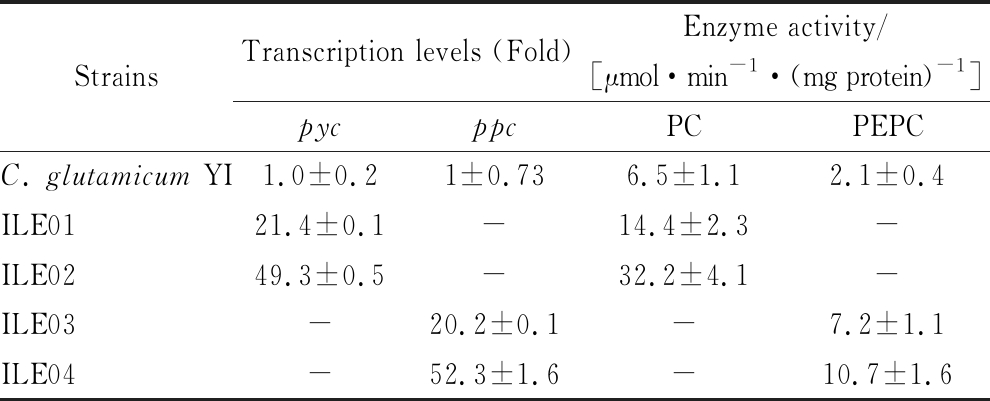
StrainsTranscription levels (Fold)Enzyme activity/[μmol·min-1·(mg protein)-1]pycppcPCPEPCC. glutamicum YI1.0±0.21±0.736.5±1.12.1±0.4ILE0121.4±0.1-14.4±2.3-ILE0249.3±0.5-32.2±4.1-ILE03-20.2±0.1 -7.2±1.1ILE04-52.3±1.6-10.7±1.6
*: -, Never detected.
2.2 Effects of pyc or ppc gene overexpression on production performance of L-isoleucine in the batch fermentations
To detect the effects of pyc or ppc overexpression on production performance of L-isoleucine, batch fermentations were performed with C. glutamicum YI, ILE01, ILE02, ILE03 and ILE04. In comparison with the L-isoleucine production and yield by C. glutamicum YI (5.2 g/L and 0.075 g/g), the production of L-isoleucine by ILE01 and ILE02 was increased by 17.3% and 9.6%, reaching 6.1 g/L and 5.7 g/L, respectively (Fig. 2); the yield of L-isoleucine by the two strains was enhanced by 12.0% and 6.7%, reaching 0.084 g/g and 0.080 g/g, respectively (Fig. 2). The production of L-isoleucine by ILE03 and ILE04 was increased by 30.8% and 13.5%, reaching 6.8 g/L and 5.9 g/L, respectively (Fig. 2); the yield of L-isoleucine by the two strains was increased by 13.3% and 6.7%, reaching 0.085 g/g and 0.080 g/g, respectively (Fig. 2). There were no differences in the biomass of ILE01, ILE03 and C. glutamicum YI. However, biomass of ILE02 and ILE04 was decreased by 26.7% and 28.4% comparing with C. glutamicum YI, respectively.
The final concentrations of byproducts in the fermentation culture, L-alanine, L-valine, L-leucine and L-lysine were measured. Accumulations of L-alanine by ILE01, ILE02, ILE03 and ILE04 were decreased by 33.3%, 27.8%, 50.0% and 30.6%, respectively, compared with C. glutamicum YI. Meanwhile, those of L-valine were decreased by 24.4%, 31.7%, 73.2% and 39.0%; and those of L-leucine were decreased by 22.7%, 40.9%, 72.7% and 50.0%, respectively. However, those of L-lysine were increased by 28.1%, 9.4%, 43.8% and 18.8%, respectively (Fig. 3).

Fig.2 The L-isoleucine production and yield as well as biomass of strains in the batch fermentations.
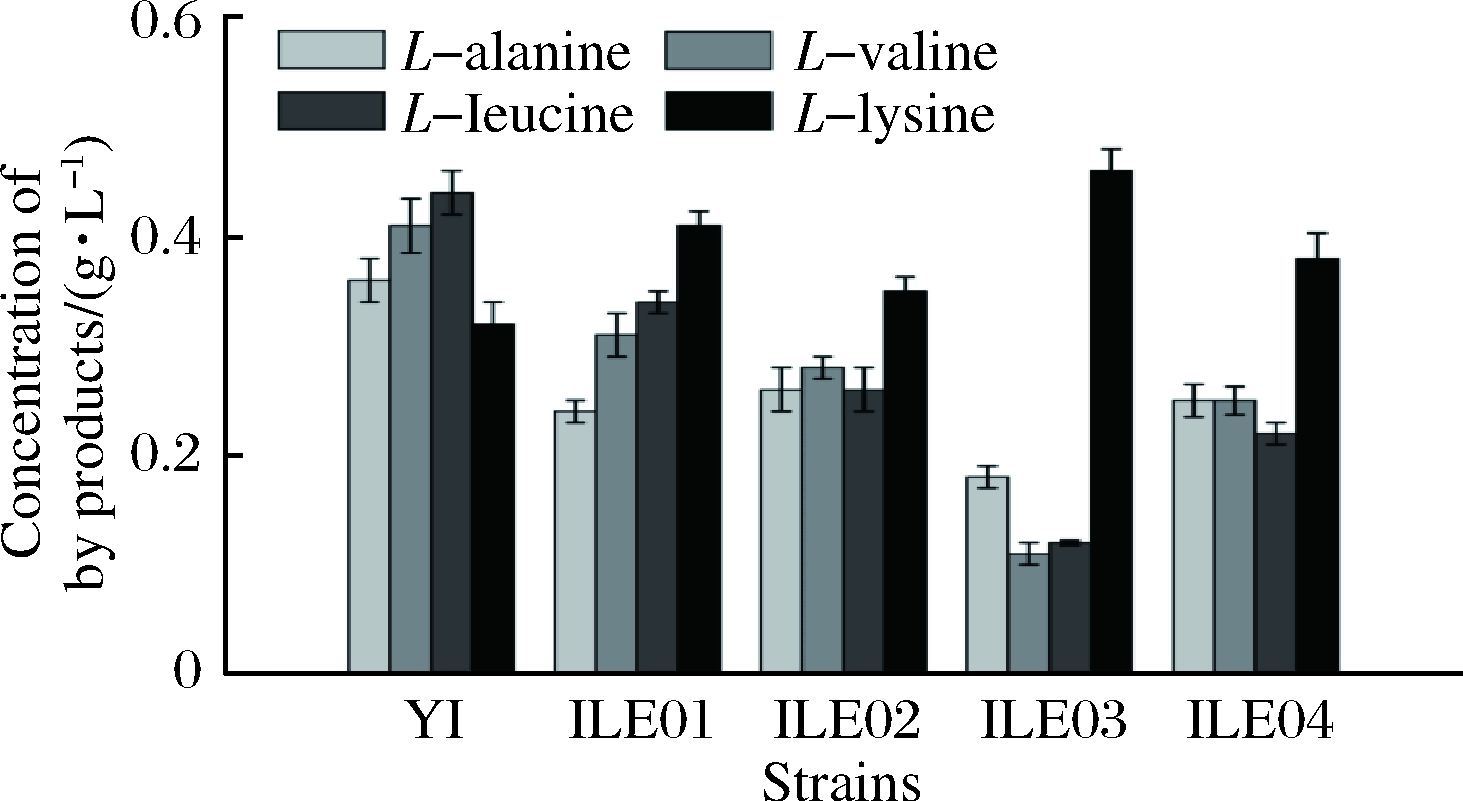
Fig.3 The final concentrations of byproducts by the constructed strains in the batch fermentations
2.3 Effects of pyc and ppc overexpression on L-isoleucine synthesis in the fed-batch fermentations
To further evaluate and compare the effects of enhancing pyc and ppc overexpression on L-isoleucine production, fed-batch fermentations of ILE01, ILE02, IL03, ILE04 and C. glutamicum YI (as control) were conducted in a 5-L bioreactor. Accumulation of L-isoleucine was observed at 4 h in all the strains. The highest L-isoleucine production and yield was achieved by ILE03 (reaching 25.7 g/L and 0.162 g/g, Fig. 4), 15.8% and 24.6% higher than that by C. glutamicum YI (22.2 g/L and 0.130 g/g), respectively. Compared with that by C. glutamicum YI, production of L-isoleucine by ILE 01, ILE02 and ILE04 was improved by 11.7%, 8.1% and 9.5%, respectively (Fig. 4). In addition, accumulation of L-alaine, L-valine and L-leucine were all remarkably declined and that of L-lysine was significantly increased (Fig. 5). Glucose consumption in ILE 01 and ILE03 was markedly lower than that in C. glutamicum YI (Table 4). ILE03 exhibited the lowest glucose consumption and the highest yield of L-isoleucine (0.162 g/g). Biomass of ILE02 and ILE04 was significantly lower than that of ILE01, ILE03 and C. glutamicum YI (Fig. 6).However, the two strains exhibited the highest specific production of L-isoleucine (1.6 g/g DCW).
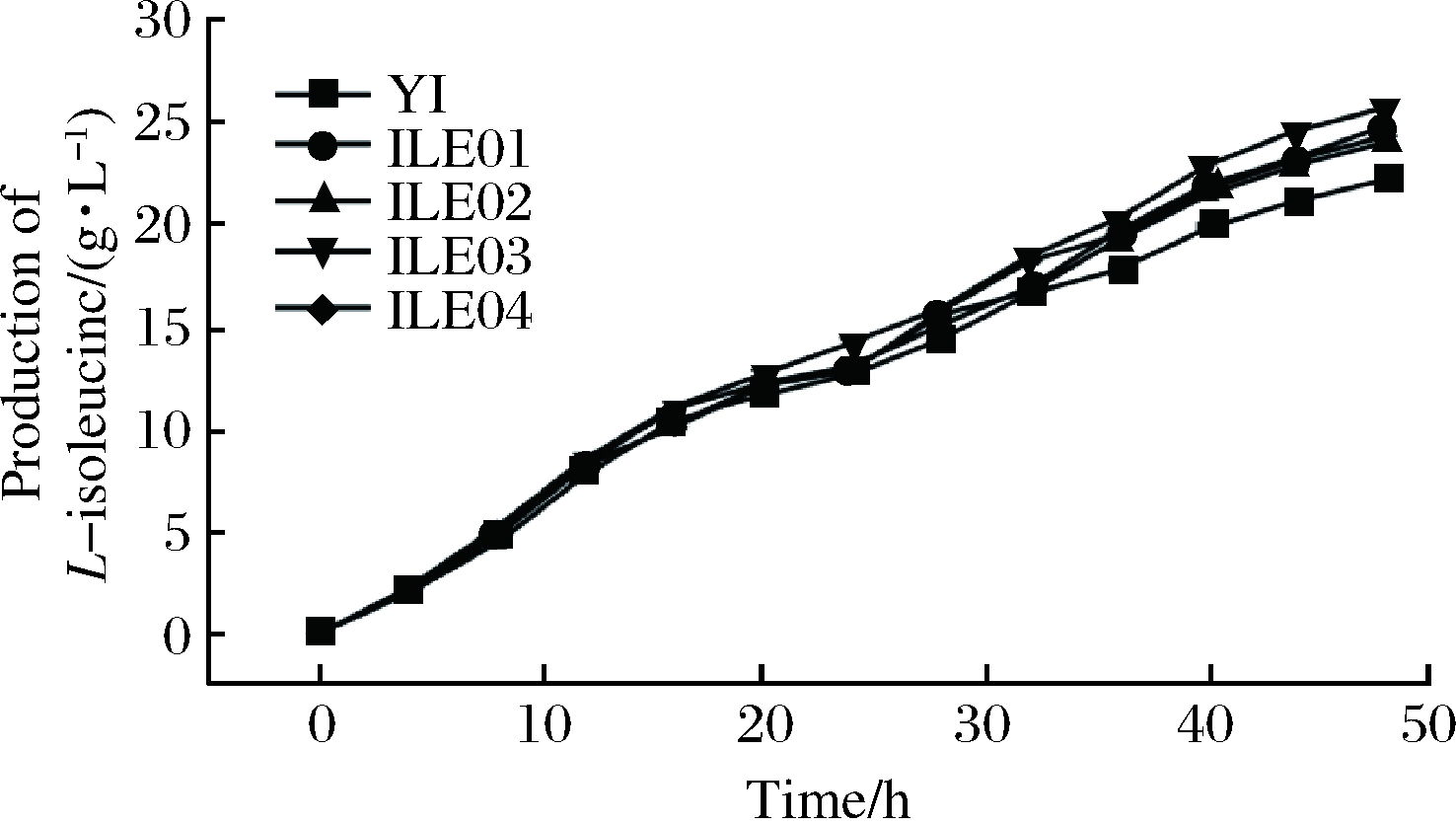
Fig.4 The production of L-isoleucine by the constructed strains in the fed-batch fermentations
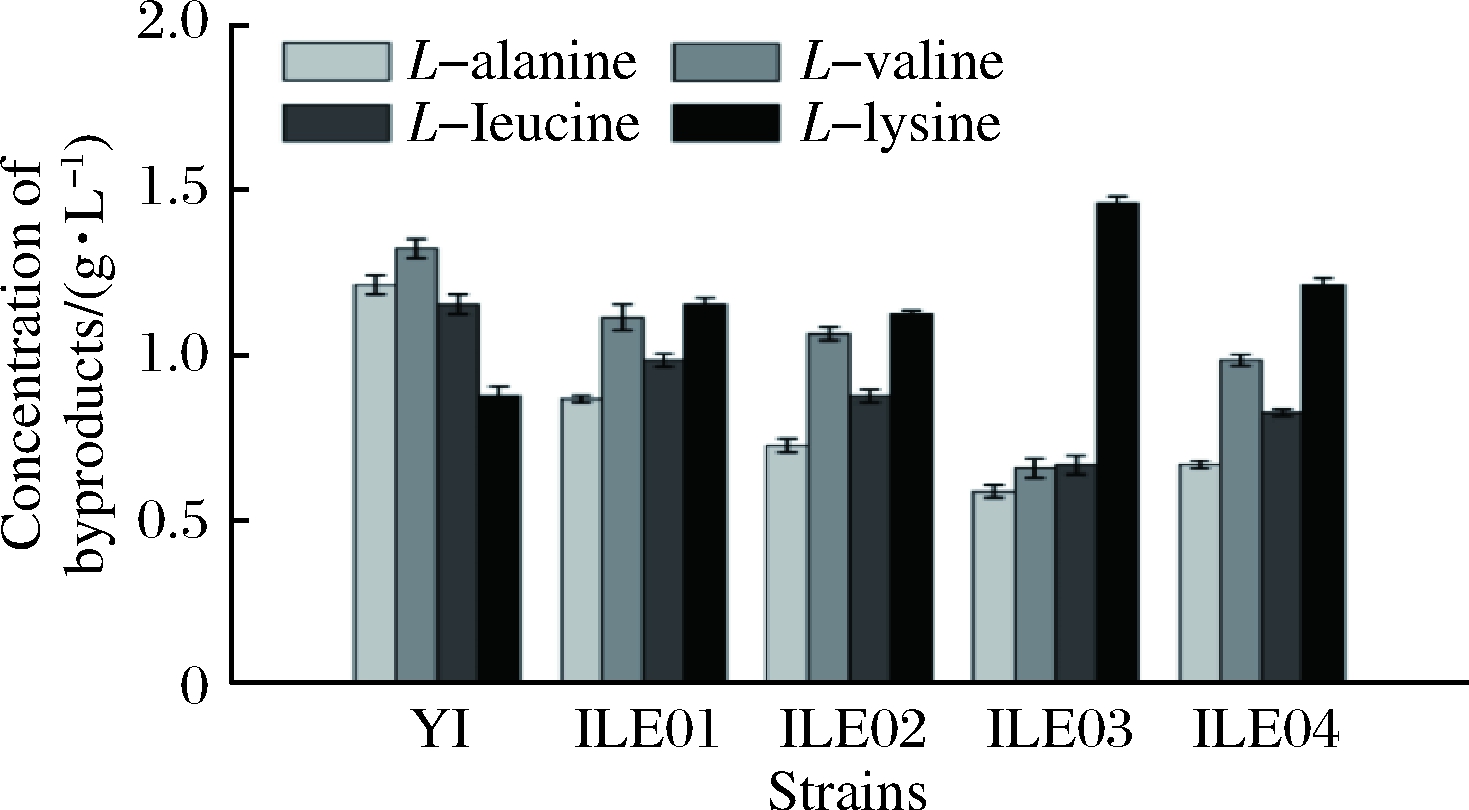
Fig.5 The final concentrations of byproducts in the fed-batch fermentations
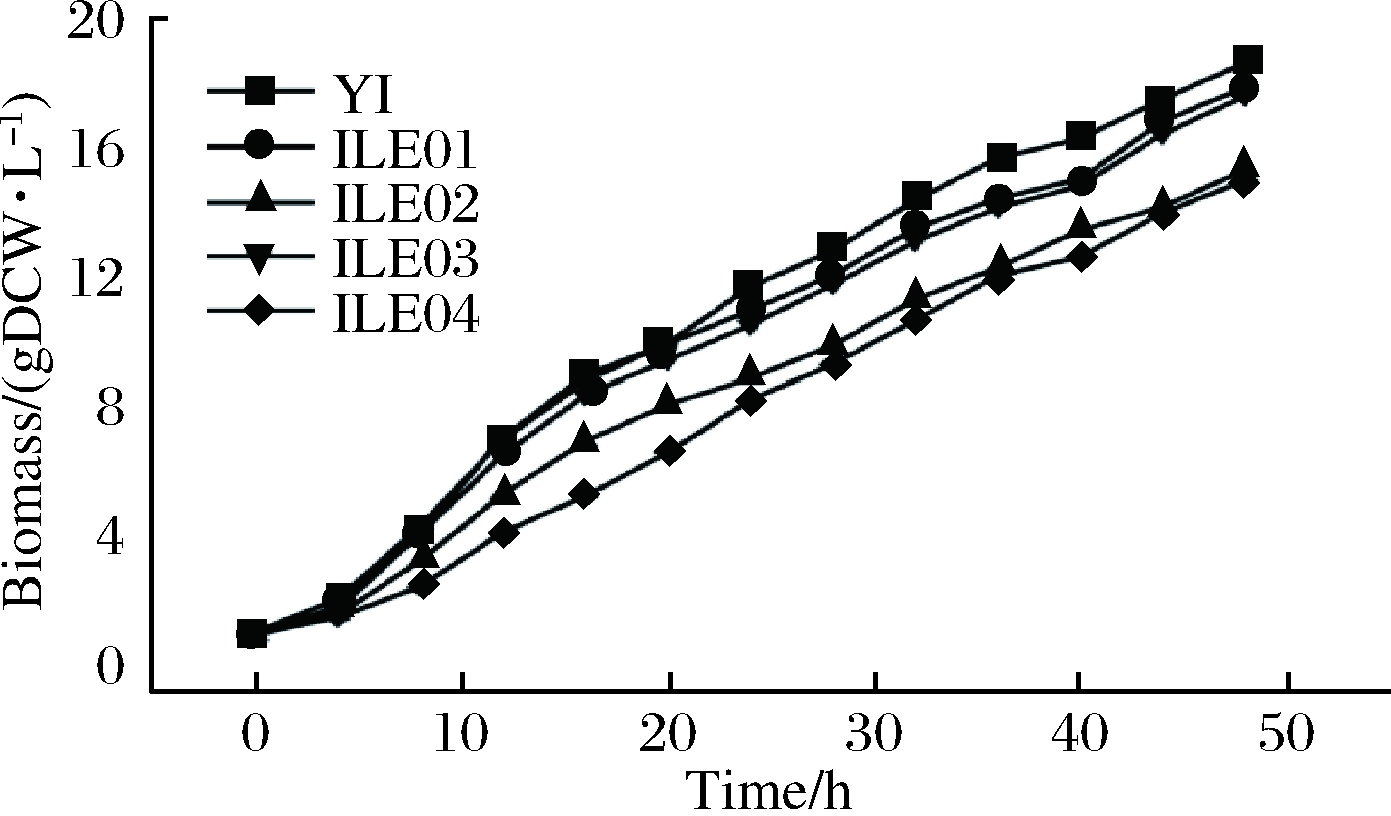
Fig.6 The biomass of the constructed strains in the fed-batch fermentations
Table 4 Fermentation parameters of strains in the fed-batch fermentations
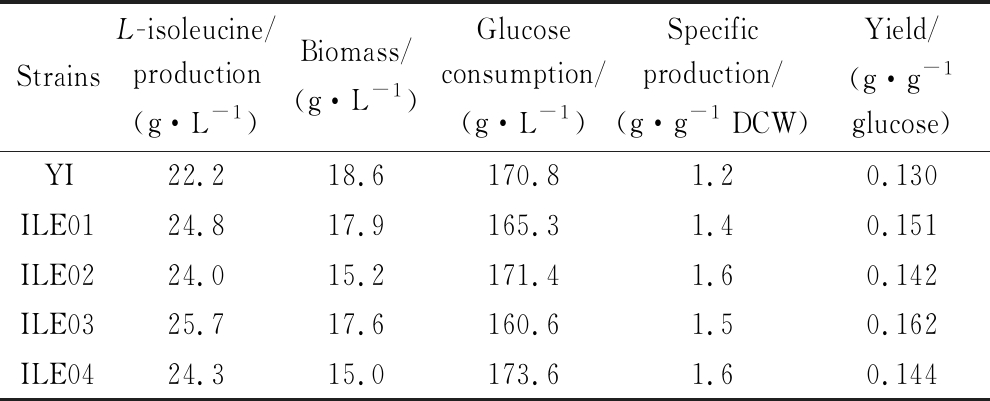
StrainsL-isoleucine/production(g·L-1)Biomass/(g·L-1)Glucose consumption/(g·L-1)Specific production/(g·g-1 DCW)Yield/(g·g-1glucose)YI22.218.6170.81.20.130ILE0124.817.9165.31.40.151ILE0224.015.2171.41.60.142ILE0325.717.6160.61.50.162ILE0424.315.0173.61.60.144
3 Discussion
C. glutamicum requires anaplerotic pathways for continuous replenishment of the TCA cycle with C4-dicarboxylic acids[18]. The anaplerotic function has generally been attributed to the carboxylation at the phosphoenolpyruvate-pyruvate-oxaloacetate node to replenish oxaloacetate[19]. It is well-known that oxaloacetate is the direct precursor for the AFAAs, to which L-isoleucine belongs[20]. C. glutamicum harors the two enzymes of PEPC and PC and both are active during cell growth and amino acid production on glucose but play different roles in amino acid synthesis[5, 8, 19, 21]. In this study, ppc and pyc were overexpressed by replacing the native promoter with the strong and constitutive promoter ![]() by inserting the genes to plasmid also driven by Ptuf and the effects on production of L-isoleucine were compared.
by inserting the genes to plasmid also driven by Ptuf and the effects on production of L-isoleucine were compared.
Our results indicate that overexpression of pyc and ppc both resulted in remarkable promotion of L-isoleucine production and yield. Together with the results that pyruvate-derived byproducts (L-alanine, L-valine and L-leucine) accumulations were significantly decreased and those of L-lysine were increased, it is definitely that pyc and ppc overexpression could increase the carbon flux to oxaloacetate for biosynthesis of L-isoleucine. But it is surprising to find that effect of ppc overexpression was more significant, achieving a 15.8% increase in L-isoleucine production. Nevertheless, PEPC contributes only 10% of the total flux for oxaloacetate synthesis in C. glutamicum according to the previous report[23]. In C. glutamicum, PEPC is feedback inhibited by L-aspartate and α-ketoglutarate[24]. So far, certain mutations in PEPC have been revealed to release the feedback inhibition and contribute to increased production of L-glutamate and L-lysine[25]. However, these reported mutations (D299N, R620G, K653G, K813G, S869G, R873G and N917G) did not happen in the PEPC of C. glutamicum YI. Obviously, the enhanced L-isoleucine biosynthesis in ILE03 and ILE04 indicates that the PEPC is most likely to have already been deregulated of feedback inhibition and functions well to supply oxaloacetate. This may be due to the point mutations of G241D, K383N, T829R, S837A existing in PEPC of C. glutamicum YI, which may individually or in combination lead to the desensitized feedback inhibition. The inhibited effect of L-aspartate on PEPC from crude cell extracts of C. glutamicum YI, ILE03 and ILE04 was tested and it was found that the inhibition was deregulated (data not shown). Furthermore, ppc from C. glutamicum ATCC 13032 was overexpressed in C. glutamicum YI, which resulted in limited production of L-isoleucine (5.5 g/L in batch fermentation, lower than that in ILE01, ILE02, ILE03 and ILE04). These results indicate that overexpression of ppc encoding PEPC released from feedback inhibition is more beneficial for upgrading production of L-isoleucine.
Notably, higher specific activities of PC and PEPC in ILE02 and ILE04 did not lead to promote L-isoleucine production compared with ILE01 and ILE03 in both batch and fed-batch fermentations, but resulted in declined biomass, which might due to the burden brought by plasmids. The results indicate that the genome-integration overexpressing strategy is more suitable for metabolic engineering of strains than the plasmid-based strategy.
In conclusion, overexpression of pyc and ppc results in enhanced production and yield of L-isoleucine, and the genome-integration overexpressing strategy is more profitable. This study first reports that expression of PEPC released from feedback inhibition, rather than PC is more advantageous for metabolic engineering modification of L-isoleucine producing strains.
[1] PARK J H, OH J E, LEE K H, et al. Rational design of Escherichia coli for L-Isoleucine Production[J]. ACS Synthetic Biology, 2012, 1(11): 532-540.
[2] LI Y, WEI H, WANG T, et al. Current status on metabolic engineering for the production of L-aspartate family amino acids and derivatives[J]. Bioresource Technology, 2017, 245: 1 588-1 602.
[3] LEUCHTENBERGER W, HUTHMACHER K, DRAUZ K. Biotechnological production of amino acids and derivatives: Current status and prospects[J]. Applied Microbiology and Biotechnology, 2015, 69(1): 1-8.
[4] CHEN Z, BOMMAREDDY R R, FRANK D, et al. Deregulation of feedback inhibition of phosphoenolpyruvate carboxylase for improved lysine production in Corynebacterium glutamicum [J]. Applied and Environmental Microbiology, 2014, 80(4): 1 388-1 393.
[5] GERSTMEIR R, WENDISCH VF, SCHNICKE S, et al. Acetate metabolism and its regulation in Corynebacterium glutamicum[J]. Journal of Biotechnology, 2003, 104(1-3): 99-122.
[6] SAUER U, EIKMANNS B J. The PEP-pyruvate-oxaloacetate node as the switch point for carbon flux distribution in bacteria[J]. FEMS Microbiology Reviews, 2005, 29(4): 765-794.
[7] DELAUNAY S, UY D, BAUCHER M F, et al. Importance of phosphoenolpyruvate carboxylase of Corynebacterium glutamicum during the temperature triggered glutamic acid fermentation[J]. Metabolic Engineering, 1999, 1(4): 334-343.
[8] SATO H, ORISHIMO K, SHIRAI T, et al. Distinct roles of two anaplerotic pathways in glutamate production induced by biotin limitation in Corynebacterium glutamicum[J]. Journal of Bioscience and Bioengineering, 2008, 106(1): 51-58.
[9] GUO Xuan, WANG Jing, XIE Xixian, et al. Enhancing the supply of oxaloacetate for L-glutamate production by pyc overexpression in different Corynebacterium glutamicum[J]. Biotechnology Letters, 2013, 35(6): 943-950.
[10] PETERS-WENDISCH P G, WENGISCH V F,DE GRAAF A A, et al. C3-carboxylation as an anaplerotic reaction in phosphoenolpyruvate carboxylase-deficient Corynebacterium glutamicum[J]. Archives of Microbiology, 1996, 165(6): 387-396.
[11] GUBLER M, PARK S M, MIKE J, et al. Effects of phosphoenolpyruvate carboxylase deficiency on metabolism and lysine production in Corynebacterium glutamicum[J]. Applied Microbiology and Biotechnology, 1994, 40(6): 857-863.
[12] SAMBROOK J, MACCALLUM P, RUSSELL D. Molecular Cloning: A Laboratory Manual[M]. New York: Cold Spring Harbor Laboratory Press, 2001.
[13] EGGELING L, BOTT M. Handbook of Corynebacterium glutamicum[M]. Boca Raton: CRC Press, 2005: 520-521.
[14] BECKER J, ZELDER O, H FNER S, et al. From zero to hero-design-based systems metabolic engineering of Corynebacterium glutamicum for L-lysine production[J]. Metabolic Engineering, 2011, 13(2): 159-168.
FNER S, et al. From zero to hero-design-based systems metabolic engineering of Corynebacterium glutamicum for L-lysine production[J]. Metabolic Engineering, 2011, 13(2): 159-168.
[15] LIVAK K J, SCHMITTGEN T D. Analysis of relative gene expression data using realtime quantitative PCR and the 2-ΔΔCT method[J]. Methods, 2001, 25 (4): 402-408.
[16] SAWADA K, ZEN-IN S, WADA M, et al. Metabolic changes in a pyruvate kinase gene deletion mutant of Corynebacterium glutamicum ATCC 13032[J]. Metabolic Engineering, 2010,12 (4): 401-407.
[17] DE FORCHETTI S R M, CAZZULO J J. Some properties of the pyruvate carboxylase from Pseudomonas fluorescens[J]. Microbiology, 1976, 93 (1): 75-81.
[18] YOKOTA A, SAWADA K, WADA M. Boosting anaplerotic reactions by pyruvate kinase gene deletion and phosphoenolpyruvate carboxylase desensitization for glutamic acid and lysine production in Corynebacterium glutamicum[J]. Advances in Biochemical Engineering-Biotechnology, 2017, 159: 181-198.
[19] PETERS-WENDISCH P G, WENDISCH V F, PAUL S, et al. Pyruvate carboxylase as an anaplerotic enzyme in Corynebacterium glutamicum[J]. Microbiology, 1997, 143(4): 1 095-1 103.
[20] ZHANG Chenglin, LI Yuan, MA Jie, et al. High production of 4-hydroxyisoleucine in Corynebacterium glutamicum by multistep metabolic engineering[J]. Metabolic Engineering, 2018, 49: 287-298.
[21] PETERS-WENDISCH P, SCHIEL B, WENDISCH VF, et al. Pyruvate carboxylase is a major bottleneck for glutamate and lysine production by Corynebacterium glutamicum[J].Journal of Molecular Microbiology and Biotechnology, 2001, 3(2): 295-300.
[22] KIND S, JEONG W K, SCHR DER H, et al. Systems-wide metabolic pathway engineering in Corynebacterium glutamicum for bio-based production of diaminopentane[J]. Metabolic Engineering, 2010, 12(4): 341-351.
DER H, et al. Systems-wide metabolic pathway engineering in Corynebacterium glutamicum for bio-based production of diaminopentane[J]. Metabolic Engineering, 2010, 12(4): 341-351.
[23] PETERSEN S, DE GRAAF A A, EGGELING L, et al. In vivo quantification of parallel and bidirectional fluxes in the anaplerosis of Corynebacterium glutamicum[J]. Journal of Biological Chemistry, 2000, 275(46): 35 932-35 941.
[24] NAGANO-SHOJI M, HAMAMOTO Y, MIZUNO Y, et al. Characterization of lysine acetylation of a phosphoenolpyruvate carboxylase involved in glutamate overproduction in Corynebacterium glutamicum[J]. Molecular Microbiology, 2017, 104(4): 677-689.
[25] WADA M, SAWADA K, OGURA K, et al. Effects of phosphoenolpyruvate carboxylase desensitization on glutamic acid production in Corynebacterium glutamicum ATCC 13032[J].Journal of Bioscience and Bioengineering, 2016, 121(2): 172-177.